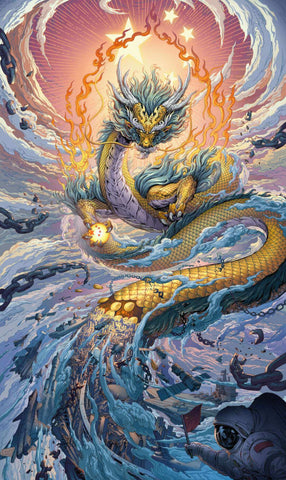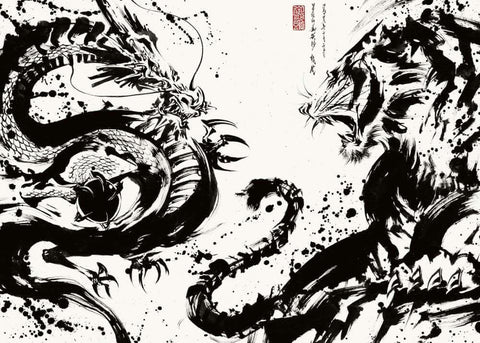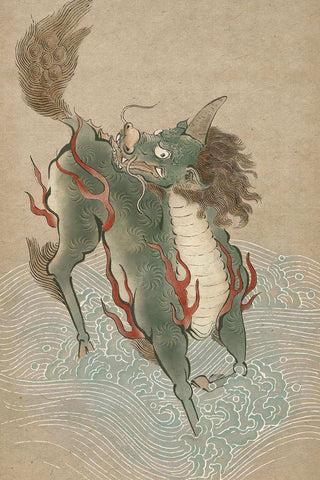The Cultural Connotation of Chinese Zodiac
The twelve Chinese zodiac signs, also known as "shuxiang" in Chinese, are twelve animals representing people’s year of birth associated with the Twelve Earthly Branches, including Rat, Ox, Tiger, Rabbit, Dragon, Snake, Horse, Goat, Monkey, Rooster, Dog, and Pig. The natural habits of the twelve Chinese zodiac animals are given many cultural connotations. They mean much more than what they are to the Chinese people, who worship and respect them. The images of these twelve animals are complete only when we combine their natural characters and symbolic meanings.
Rats are fertile, and they are a sign of the production worship. They also enjoy a keen sense to danger, so the mining workers respect them, and pass their worship and awe to them from generation to generation. Mining workers in the northeastern provinces revere them as "the fairy rats". They never trap the rats, and even give them food when dining under the mines. An old mining area in Yunnan Province has a temple for the rats.
Tiger is thought to be the king of all the beast and a symbol of fierceness and masculinity. The Yin character, from the Twelve Earthly Branches representing the tiger, has the shape of an arrow. In Explaining Characters, Yin means "Yangqi moves from inside of the earth, breaking through even the frozen earth beneath it ", matching with the power of tiger.

The worship to dragon is a tradition in China. The Book of Changes referred the sky and earth to the dragon and tiger, for the former flies in the sky and the later walks on the ground. The picture of "prosperity brought by a dragon and phoenix" was symbolic of Chinese culture after Tang Dynasty, meaning the power of the emperor and empress, the perfect combination of a couple, and the harmony between matters and spirits.
The Unauthorized Biography of Han Ying’s Poems summarized the "five merits" of the rooster : the comb as education; the claws as martial arts; the fighting spirit as bravery; calling each other when finding food as loyalty; punctuality in the morning crow as integrity. Therefore, the rooster is also named "the bird of merits".
People praise the loyalty of dogs very often. Yishu Yi recorded that dog named "yellow-ear", owned by Lu Ji, a famous calligrapher in Western Jin Dynasty, carried a letter for its master and died of tiredness. The "black dragon dog" in Soushen Ji saved its drunken master by splattering water on him in a fire.
Each zodiac sign is given some special characters by people, which helps this unique culture to pass on.
Folk Traditional about Chinese Zodiac
Folk activities about Chinese zodiac are varied and rich. Majorly they are seasonal activities, social etiquette, clothing and entertainment, food and drink. Due to the changes in social lifestyle, the ethnic group and geographical differences, these activities vary in contents and forms.
In the Qing dynasty, there was a holiday named "Warehouse Fulfilling Holiday", when the merchants who sold rice prayed to the rat, "the god of the warehouse". According to Notes about Seasons in Beijing by Pan Rongsheng, "It was near the Warehouse Fulfilling Holiday, the warehouse were empty, and we should put in crops to refill them." At the night of the holiday, people should not light up, in order not to interfere with the marriage of the rats. At the day when the rats got married, people fired soybeans and blended these with brown sugar, and put these soybeans in the corners of their house. Different places had different traditions about the day. Some people scattered salt and rice in the house corners. They called it "share the money with rats". Some people steamed 12 dough without eyes on the 14th day of the first month in lunar calendar, and served them as tributes on the 15th, the Lantern Festival, to pray for the rats leaving their crops alone.

"Whipping the oxen in spring " was popular in recent years in rural areas, also known as "whipping the spring", to boost farming and announce the beginning of the new-year labor. Farmers put five kinds of crops into a paper-made ox, whipped it and scattered the crops, symbolizing "all crops flowing with wonderful harvest". Back in the Qing Dynasty, the officials distributed The Picture of Spring Ox and the "God of Crops" to the farmers. In the picture, colors of all parts of the ox as well as the age, dress and position of the "God of Crops" were designed according to the relationship of the Heavenly and Earthly Branches of the year, and that of the five elements and yin-yang. The picture also served as an almanac.
In many places, cloth toy tigers are popular. People think tigers are gods who protect children. So the children wear hats and shoes with tiger sign. In this way, they were thought to be protected bu the Tiger God. Uncles give nephews tiger-shaped pillows ad presents on their birthday. In some province uncles present nephews with yellow cloth tigers, when the nephews reach one year old and break off the tiger’s tails when passing the threshold, meaning "to throw away the hardships (kanke, kan means threshold)". Children from some ethnic groups wear tiger claw and teeth to drive away the evil spirits. From the Zhou Dynasty to the Han Dynasty, people drew tigers on their gates as their "God of the door" to protect their house. The people in northern parts of China used to have a kind of New Year Picture named "Picture of the Godly Tiger Protecting the House", saying "The godly tiger comes down from a high mountain it dwells, into human world it casts the holy spell. After the good people buy this picture, in all seasons they will live safe and well."

Traditions about Dragons dated back long. The "Dragon-Head-Raising Day" on the 2nd day of the 2nd month in the lunar calendar, was deemed to be the time when the crouching dragon was raising its head, so more rain came. People had their hair dressed on the day to gain the spirit like the dragon. Northern people made a string with straws and colored paper and hanged it on the beam, calling it "the string of the dragon tail". They ate noodles, baked pancakes and dumplings on this day, for these food looked like dragon whiskers, scales and ears. Besides, the Chinese have dragon-related festivals every month, such as the "dragon sacrificing festival" of the Yao Ethnic Group of Yunnan Province in the 1st month in the lunar calendar; the "dragon king sacrificing festival" of Shandong Province in the 3rd month; the fair of Leiyin Temple of Datong city, Shanxi Province in the 4th month; the "Dragon Division Festival" of Jiaxing City, Zhejiang Province in the 5th month; "Bask the Dragon Costume" in the 6th month; the "Dragon Girl Temple Fair" in the 7th month, etc.
The northern nomadic groups were in the worship of horse. A legend named "snow-white horse god" was told in Bao’an Ethnic Group. The Dawo’er Ethnic Group called the horse god "Wengu", which was not allowed to bi ridden by females. The Man Ethnic Group also consecrated the horse god.

A goat with one horn named "Xiezhi" in the ancient legends is the assistant of Gao Yao, the god of jurisdiction. Wang Chong said in Lun Heng, Chapter Shiying, "When Gao Yao made the judgment, Xiezhi knocked the suspects over when they were guilty, and left them unscathed when they were not."
Up to now, the saying of "year of one’s own animal" have been still popular. People also call it "year of one’s Chinese zodiac", which means the year represented by the same animal with that of the year they were born in, met by one in every 12 years. It was said that "in this year, you are in conflict with the Jupiter(Taisui in ancient Chinese), and there will be troubles instead of happiness." The year of one’s Chinese zodiac is thought to be lacking in luck, so it is also called "the year of vicissitudes". Traditional about wearing red to avoid evil things in this year are prevalent all over China. Everyone, old and young, changes into red underwear, red belt and other red decorations like red scarf or necklace, in the day before the year of their Chinese zodiac, which is called "the red of one’s own animal". In some place, on the night of this day, people should not go out; a married man should be accompanied by ladies.
Ancient people valued names very much. They thought names should make up for the luck, and the Chinese zodiac is an important reference for naming. Zhou yinlong, a litterateur in the Song Dynasty, was born on the hour of Ren (Dragon), so he was named Yinglong (long means dragon). Tang Bohu, a famous artist in the Ming Dynasty, was said to born on the hour. Month and year of Yin(tiger),so he was named Tang Yin. People used to give their children "lower" pet names, and they thought in this way the children would be raised easily. Shu Qingchun (pen name Lao She), a famous writer, had a per name of "little dog tail", for he was born on the year of dog. The painter Ye Qianyu’s name was "A Yang(goat)".
People of Han Ethnic Group used pigs for all the great sacrificing activities, and the head of the pig was the most valued. Wu Guren said in Miscellaneous Poems of the New Year, "It is a tradition of the Hangzhou City to use pig head for sacrificing...Choose the ones with wrinkles like a character shou (long life), named ‘pig head with Shou character’." Up to now people in Zhejiang Province still make pickled pig head as the "new year purchases" in the last month of the lunar year. On Tomb Sweeping Festival some people used roast pigs to consecrate their ancestors. The proverb "the ancestors distribute the pork to everyone" means that the whole family can eat the sacrifices after the rite. In the old times, some people would have the elderly set up a table for burning incense when severe disasters happened to the family, for beating the "sow ghost". They saying was "kill a sow ghost and drive away an evil spirit". They would pick a lucky day, kill an old sow and put its entrails inside of the house. After the sacrifice they ate these entrials.
People have other traditions about Chinese zodiac in marriage, agriculture, character or the destiny of the nation.

In a word, Chinese zodiac is a specific culture enjoyed by the Chinese in their traditions. It was easy to understand, and interesting to practice, so it was passed down till today and became a precious non-material cultural heritage. In the modern society, it has turned into an irreplaceable ethnic symbol and spiritual token.
Chinese zodiac: Origin, Culture
Scorpion adică cocoș cred eu
Leave a comment